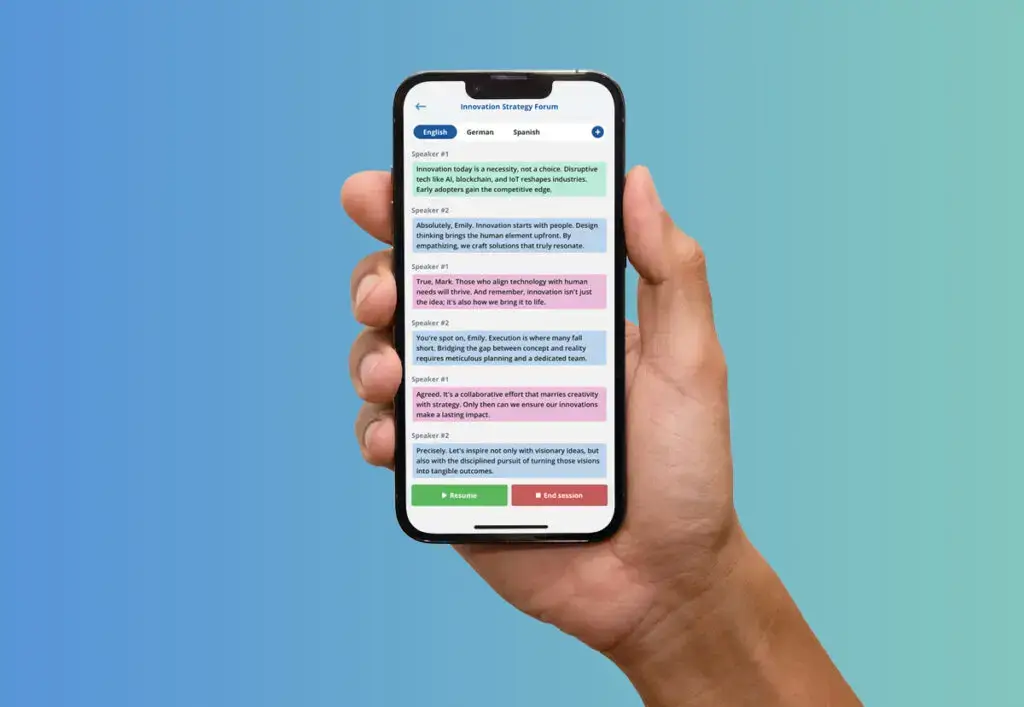Artificial intelligence (AI) and how to use AI tools are a hot topic. But maybe not for everyone. We found that one out of every two on-demand remote interpreters are unfamiliar with AI interpreting tools. Our findings began when we surveyed remote interpreters in late 2023 on their current usage of AI. In other words, are you using AI in your interpreting encounters?
Judging by the 133 mainly negative (“No” or “I’m not familiar with AI”) responses that we got when we sent out the question on current usage, AI was not as “hot” as we thought. Not yet at least.
Still, whether we like it or not, AI is not a distant future concept but a growing reality, like a tidal wave in its early stages. Our recent AI report revealed that AI tools can enhance interpreter performance. However, there is a need for greater awareness of these tools within the on-demand profession.
This slow adoption of AI in on-demand remote interpreting contrasts with its faster integration in other segments of remote interpreting, such as remote simultaneous interpreting (RSI), where AI’s impact is more evident. On-demand interpreting needs careful AI integration that suits its unique challenges, needs, and workflows.
A tailored approach to using AI is a truism for all professionals. This truism is especially true among remote interpreters, who require different technologies, skill sets, and training based on the remote interpreting modality and setting where they provide interpretation services.
In this blog, we’ll explore 5 AI tools helpful to interpreters, and then we look at where they stand regarding their limitations, ethical considerations, and privacy concerns.
Types of Remote Interpreting Encounters
- On-demand Over the Phone Interpreting (OPI) and Video Remote Interpreting (VRI)
- Pre-schedule OPI/VRI
- Remote simultaneous interpretation
What is The Best AI Tool For Interpreting?
Language professionals have a growing selection of AI tools to help with daily tasks. The best AI tool depends on what context they need it for. Remote interpreters found AI Chatbots, live captioning software, and terminology management tools most helpful.
Imagine for a second that you’re an on-demand interpreter called into an assignment on mortgage insurance without any preparation. Your ability to quickly understand the context and terminology used in the conversation is essential for the session to go well.
This is common for remote interpreters who become mini experts in the topics they interpret. An AI chatbot like ChatGPT can help by giving a quick summary of the session topic in real-time. This is useful when the interpreter needs to understand the specific terms used.
In recent years, interpreters have explored AI tools with broad applications to address specific interpreting workflow tasks. While AI can augment interpreter performance, its limitations must also be addressed. Interpreters must practice good judgment and rely on their expertise when integrating AI-powered programs.
5 AI Tools for Interpreters
1. ChatGPT
Developed by Open AI, ChatGPT is a large language model that can generate human-like responses based on the prompts it receives. ChatGPT understands and creates clear responses in everyday language. It can be useful for content creation, research, planning, and more.
ChatGPT has advanced natural language processing capabilities and can retrieve information instantly. Interpreters and translators can benefit from ChatGPT primarily as a powerful tool for research, assignment preparation, and glossary creation. The program can assist with over 50 languages. However, it is important to exercise caution when using it for multiple languages. This is because the accuracy of the program will vary depending on the specific language.
ChatGPT is like Wikipedia in that it can give you an excellent first look at information, but further research is necessary to check the validity of the data provided. ChatGPT helps language professionals create glossaries and translations, but users should independently verify the information’s accuracy. For example, most Swahili online comes from machine translation of English content. If you ask ChatGPT to translate it back into English or another language, errors can multiply.
ChatGPT does protect user data to some extent by offering controls over data management and committing not to sell data to third parties; it does collect a wide range of personal and conversation data. Users should be mindful of the information they share and utilize available settings to manage their privacy.
Interpreters can use ChatGPT for the following tasks:
- Research and terminology preparation before an interpreting assignment
- Glossary creation for target languages
- Quick queries in real-time for on-demand or pre-scheduled consecutive interpretation and remote simultaneous interpretation
- Content creation and email drafting
2. DeepL
DeepL is an AI tool that uses deep learning to create high-quality translations of words and phrases. The program works similarly to Google Translate but has advanced capabilities to help interpreters understand a given sentence’s context. Upon analyzing a statement, its dictionary, glossary, and alternative suggestions features can benefit interpreters as they capture linguistic nuances.
Its paid version DeepL Pro, which costs between $8.47 and $57.49 per month, offers extra features such as translating various file formats. This can be very helpful for preparing to interpret. You can translate a speaker’s presentation roughly. Then, you can improve the translation of important words and ideas. DeepL Pro also takes extensive measures to protect user data.
We learned from on-demand remote interpreters that DeepL translations can still be flawed. A user shared their experience with the tool, saying that AI doesn’t fully understand how phrases are constructed in different languages. “AI can be helpful, but it’s mostly 50/50.” That said, interpreters must maintain good judgment when referencing the provided translations. DeepL balances speed and quality, benefiting interpreters when used thoughtfully.
Interpreters can use DeepL for the following tasks:
- Translation of materials and terminology preparation before an interpreting assignment
- Glossary creation for target languages
- Quick queries in real-time for on-demand or pre-scheduled consecutive interpretation and remote simultaneous interpretation
3. Dragon Speech Recognition
Dragon Speech Recognition (DSR) is a voice recognition program developed by Nuance Communications. DSR uses advanced speech-to-text technologies to convert spoken words into written text accurately. They also prioritize the protection of user data through encryption and safeguard protocols.
The system works for 86 languages. Subtitles can assist interpreters in real-time if the speaker has a strong accent or poor audio quality. The program can also provide a clear and accurate transcript of a speaker’s message without manual transcription.
Interpreters like the tool because it helps them with accents and audio issues, according to Slator. We found this to be true in our survey. A remote interpreter used live captioning tools to understand a provider with a strong accent. This helped them avoid asking for repeated explanations.
Interpreters can use DSR for the following tasks:
- Remote simultaneous interpretation
- Transcript creation and automation
4. Boostlingo AI Pro
Boostlingo AI Pro changes spoken words to text and provides translated captions in over 130 languages. AI-generated translated captions are helpful for interpreters in online meetings, virtual conferences, and hybrid events. The tool instantly translates and gives meeting transcripts, removing the need to upload and convert them manually.
Interpreters can use Boostlingo AI Pro for the following tasks:
- Remote simultaneous interpretation
- Transcript creation, translation, and automation
5. InterpretBank
InterpretBank is a computer-assisted interpreting tool. It allows interpreters to prepare specialized assignments, manage terminology, and access information in the booth or on the go. The tool uses AI, smart design, and advanced tech to help interpreters in their work. Interpreters can make and save glossaries in different languages. The tool has advanced AI features like speech recognition to increase efficiency.
InterpretBank has a cloud tool called ASR. This tool assists interpreters in booths by listening to the speaker and automatically searching for terms, names, and numbers. Additionally, it provides a Digital Notepad for note-taking during assignments.
Different editions are available to cater to the needs of freelance interpreters and agencies. The most popular plan is Freelancer – Subscription, priced at €9.99 monthly. Its counterpart, Freelance – Perpetual, is €249.99 per month, while Enterprise is €29.99 per month. These plans give users additional capabilities such as Glossary sharing, AI automatic glossary creation, and more.
Interpreters can use InterpretBank for the following tasks:
- Remote simultaneous interpretation
- Glossary and terminology management
- Note-taking
AI Tools for Interpreting: Limitations, Ethical Considerations, and Privacy Concerns
We are excited about integrating AI tools into the language industry. However, since AI technology is still in the early stages of development, it should not be the only solution used in sensitive or complex situations. Taking reliability concerns into account, using them without clear disclaimers might raise safety and liability issues for end users.
Data privacy is also a concern. Developers of language-specific AI programs are aware of this issue and protect their users with data privacy policies.
Tools like Interpret Bank clearly state in their terms and conditions that they only process users’ data with their consent. They use this data only to improve their content and services. Additionally, they stay compliant with data protection laws like GDPR and never share information with third parties.
Before you use AI tools in your interpreting encounters, always remember to:
- Check employer, client, and platform policies on AI usage
- Disclose to and get permission from all participants when you are using AI tools
- Study best practices for using AI safely
We should closely monitor the use of AI tools in regulated industries like healthcare, education, and legal. Interpreters working in these industries must get the approval of their LSPs and clients before using AI for their encounters.
Responsible AI users learn how these programs process, store, and manage user data. They also try to educate their clients about AI tools and their potential impact on privacy.
Learn how AI can help, not harm in language services in our on-demand webinar.
Understanding the State of AI in the Language Industry
Artificial intelligence tools will continue to evolve and assert their relevance in the language services industry. While they may have significant limitations with AI, there’s no denying that these programs can help interpreters. In the coming years, we expect AI usage to grow in the language industry and increase access to language services.
As integration continues to rise, staying updated with the latest AI trends is a must for every language professional. If you’re interested in learning more, read our whitepaper on the current state of AI in the language industry!





